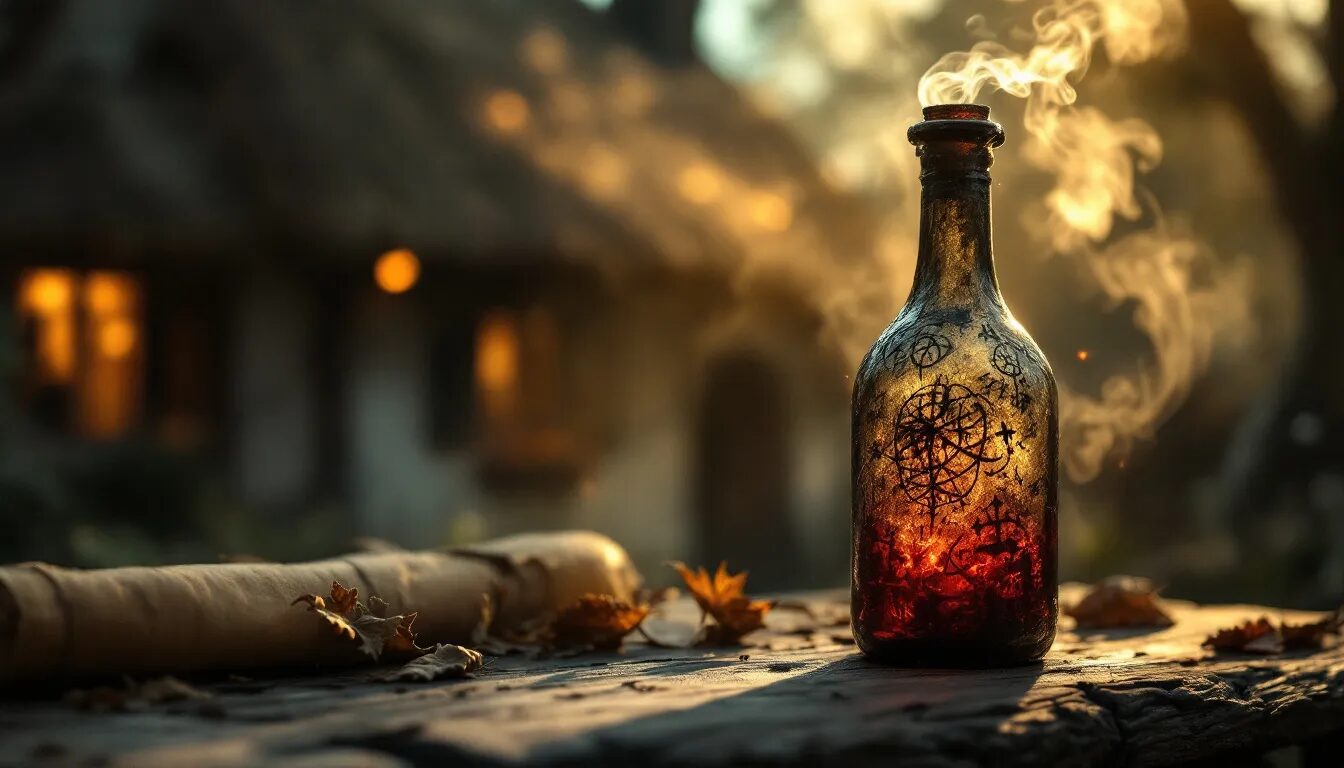Farm‑field backhoes hit a glass talisman sealed three centuries ago; now curators, scientists, and spell‑craft diehards are battling over whether to pop the cork or leave its magic sleeping
WARWICKSHIRE, ENGLAND— The August sun hadn’t burned off the morning mist when a pair of contract diggers widening an irrigation trench on Ashby Hill Farm felt the bucket rattle against something that wasn’t sandstone. Out rolled a half‑pint, hand‑blown glass bottle—thick‑walled, olive‑green, its neck blackened by soot. The vessel was intact, and the liquid inside—a cloudy amber swirl flecked with rust flakes—sloshed ominously as archaeologist Hollis Bramwell cradled it in gloved hands. Within fifteen minutes, local radio had dubbed it the “Ashby Witch Bottle,”the first sealed specimen in the county’s records and potentially the best‑preserved 18th‑century counter‑hex charm found in Britain this decade.
Introduction to Folk Magic
Historical Context


The tradition of using witch bottles can be traced back to the 17th century in England and Europe. During this period, the fear of witches and their malevolent spells was pervasive, leading people to seek protection through various means, including witch bottles. These bottles were believed to act as a safeguard against evil spirits and harmful spells. The practice was carried across the Atlantic by European settlers, where it continued to evolve in the United States. Historian Chris Manning, who has extensively studied witch bottles, notes that these containers were typically filled with objects like pins, nails, and hair, all believed to hold magical properties. The use of witch bottles has been documented in numerous articles and scholarly works, highlighting their significance in the cultural and historical context of the time.
A Talisman Ready‑Made for TikTok Terror
Witch bottles were the spell‑world’s DIY home‑security system between the 1600s and early 1800s. Folk‑magicians packed them with iron nails, bent pins, human hair, and—most potently—urine, then buried them beneath hearths, fireplaces, or thresholds so any malevolent curse hurled at the household would be “drawn off” and boiled alive inside the glass. More than 200 examples have surfaced across England, mostly broken or emptied by curious renovators. Complete, cork‑tight bottles are rarer than plague‑doctor masks in mint condition.
Bramwell’s team knew the stakes: crack the seal and you gain raw material for isotope assays, DNA screening, and microscopic pollen maps that could redraw witchcraft trade routes. Break the spell, folklorists warn, and you risk reversing the bottle’s purpose—dumping centuries of concentrated bad luck onto whoever’s holding the trigger. Rural WhatsApp groups already buzz with armchair warlocks planning midnight vigils “to see if the farm’s weather shifts when the bottle finally pops.”


Contents of the Container
The contents of a witch bottle are as varied as the spells they are meant to cast. Common items found within these bottles include nail clippings, iron nails, hair, and urine, often combined with herbs, stones, and other personal items to enhance their magical potency. For instance, a witch bottle intended for protection might contain a mix of sage, rowan, and black tourmaline, arranged in a specific pattern such as a circle or triangle to amplify their effects. The inclusion of white smoke, believed to have purifying properties, is also a common practice in the creation of these bottles. Each object within the bottle is carefully chosen and placed to create a powerful spell, reflecting the intricate and thoughtful nature of this folk magic tradition.
The Lab Says “Open It.” The Museum Says “Over Our Dead Bodies.”
Within 48 hours, the artifact, discovered beneath an old home, landed in a climate‑controlled holding room at the Market Bosworth Heritage Trust. Conservation chemist Dr. Yasmin Adler squinted through an endoscope threaded past the cork, spotting what she believes are three iron nails, a twist of linen, and “clumpy sediment consistent with degraded urea.” Adler argues the sample is a once‑in‑a‑career snapshot of early‑modern fear biology: “We could DNA‑type the hair, test the urine for disease markers, and build a demographic fingerprint of a ghost‑story victim.” This discovery highlights the importance of archaeology in understanding historical beliefs and practices.
The museum board slammed the brakes. Director Lionel Grainger fears the bottle could implode under lab vacuum. Worse, he says, “If we drain it now, we’re left with another empty jug and a label. Sealed, it’s a tension bomb that makes visitors lean into the glass case.” Grainger has already sketched a dramatic exhibit mock‑up positioning the bottle under low amber light, with a heartbeat‑slow subwoofer rumble piped into the plinth. The idea is to let tourists “feel the spell vibrating—no broken glass required.”
A Legal Hex No One Saw Coming
English Heritage’s Portable Antiquities advisor dropped a bureaucratic twist: once the bottle’s contents spill, they become “environmental waste” subject to hazardous‑material disposal rules. Translation: whoever breaks the seal will need a licensed bio‑waste courier on standby and must document the pour in a lab with negative‑pressure hoods. The farm’s insurer has already asked whether a centuries‑old putrefied brew could trigger crop contamination if it leaks.
Cautionary Tales—and Yellow Warnings—From Past Unstoppers
Historians keep waving one caution flag: the Greenwich Witch Bottle, famous for spewing a sulfuric stench and lodging three curators in the infirmary when its urine‑and‑nail cocktail met fresh oxygen in 2004. The lab data it provided on early‑modern disease signatures was invaluable, but the public only remembers the evacuation alarms and gas‑mask selfies London Month of the Dead. The incident also reignited discussions about the death of the wizard responsible for the witchcraft, illustrating the potent beliefs surrounding death and magic in historical practices. Then there’s the University of Lincoln case from January, when a sealed bottle revealed little more than cloudy urine and a couple of hair strands—scientifically bland, headline‑deadly—after months of hype University of Lincoln News.
“Opening is a lottery,” says folklorist Dr. Pippa Ward. “Ninety percent of the time you get grim tea. Ten percent you get career‑making insight. One hundred percent you killed the mystery.” Ward favors a compromise: CT‑scan the bottle in situ, map every sliver of metal, and 3‑D reconstruct its interior for digital explorers. “Scan, don’t spill,” she chants to anyone who’ll listen.
The Spell‑Craft Community Smells Fresh Blood


Meanwhile, occult TikTok is chewing through the story like a piranha tank. #AshbyWitchBottle topped eight million views in two nights. Influencer “HexGirlLiv” insists the bottle must stay sealed until Samhain’s thinning‑of‑the‑veil, when it should be uncorked beneath a beech moon to “complete its karmic circuit.” Rival creator “ScienceSorcererZed” counters with a live countdown to an imagined grand opening on the autumn equinox, complete with merch.
Local pagan covens have offered “ritual containment” services. There is also a calling for the public to share their discoveries related to witch bottles, encouraging community participation in the research process. Bramwell declines politely, but privately admits she’d rather field robed volunteers to support the ritual than the rash of would‑be relic thieves the farm’s CCTV caught circling the dig site Wednesday at 3 a.m.
Money, Tourism, and a Spellbound Economy
Warwickshire’s county council sees pound signs. A sealed‑bottle exhibition could anchor a new folklore wing, driving shoulder‑season tourism long after the Anne Hathaway cottage crowds thin. The council floated a Halloween ticketed gala—fog machines, period musicians, maybe even a stunt cork‑pull streamed globally. This project aims to gather collective knowledge and understanding of shared cultural practices and beliefs throughout history. Grainger balks: “We’re a museum, not a theme park.” But his board quietly asked event planners for a “safety‑first ritual spectacle” pitch anyway.
A startup biotech firm has dangled grant money if the museum releases ten milliliters for metagenomic sequencing as an example of how modern science can intersect with historical artifacts. A fragrance house sniffing for “haunted scents” asked whether any aroma extract rights are available. Even a spirits distillery joked about a limited “Witch Bottle Gin”—charcoal‑filtered, for obvious reasons.
Preservation and Future Research
Preserving witch bottles is crucial for maintaining our cultural heritage and understanding the history of folk magic. Institutions like the Museum of London house collections of these fascinating containers, making them available for study and research. The preservation of witch bottles allows us to explore their contents, analyze their magical properties, and understand their role in both historical and modern witchcraft practices. Future research could provide deeper insights into the materials used, the spells cast, and the cultural significance of these bottles. The tradition of creating and using witch bottles continues today, with many people still crafting these containers to cast spells and seek protection. Whether you are a practitioner of witchcraft or simply interested in the rich history of folk magic, witch bottles offer a captivating glimpse into a world where magic and reality intertwine.
The Risk Nobody Wants to Say Aloud
Plant pathologist Dr. Harvey Tyndale slips into conversation a specter bigger than curses: botulism. The cork’s tar seal appears unbroken; anaerobic spores could have fermented for centuries. One microscopic tear could aerosolize lethal toxins. “Human urine isn’t sterile after three hundred years,” he quips. Bramwell immediately ordered the team to don FFP3 masks and double‑bag the artifact in an acrylic isolation case.
Decision Day Looms—And No One Trusts the Calendar
The Museum board set a public vote for October 13th—Friday the 13th, naturally—on whether to authorize lab opening. Grainger swears the date’s a scheduling coincidence; Ward rolls her eyes. The vote will be livestreamed, but rumor says an anonymous benefactor may fly in an X‑ray diffractometer and pay for every imaging test if the bottle stays sealed. That dangling carrot could twist board members who love tech toys almost as much as donor cash.
The People Who Fear It Most
Back on Ashby Hill Farm, field laborer Dan Mortimer is the person who sees the dig trench every day. “Soon as that witch bottle left, the badgers dug under the fence and spooked the heifers,” he mutters. Coincidence? Maybe. The tractor’s fan belt snapped the next sunrise. The farmhouse satellite router glitched to the point of unusability. This spells trouble for the farm’s daily operations. Mortimer’s grandmother told him once: “Break a witch bottle, break the shield.” No one’s broken this one yet, but removal alone, she insisted, might start a slow unravel.
The Final Twist—It May Not Be a Witch Bottle at All
Minutes before this story went to press, Adler noted the bottle’s base bears a partial “R & W” pontil scar—indicating it was blown at a regional works that didn’t exist until 1795, decades after witch bottles faded from feverish use. If her dates hold, the artifact sits near the tail end of witch‑bottle history, maybe even a revival piece crafted by a hedge‑witch ancestor hanging onto old ways after Parliament repealed the Witchcraft Act of 1736.
Some scholars argue late bottles were more psychological placebo than spelled weapon: you believed you were protected, therefore you were. It was thought that the bending of pins within the bottle would serve a ritual purpose, thereby connecting it to the otherworld and the magical intentions behind the spell casting. If true, the Ashby bottle might contain no weaponized nail soup, just a 230‑year‑old comfort blanket in glass form. That theory comforts no one on TikTok, where watchers crave curses more than closure.
Will science uncork a time‑capsule of panic urine and rusty nails, or will curators keep the genie swishing in its antique flask forever?
The countdown to October 13th ticks on. In the spotlight: a palm‑sized bottle sealed by trembling 18th‑century hands, vibrating now with the hopes, fears, and click‑thirst of a 21st‑century crowd that still wants to believe spells can sprint across centuries—and that maybe, just maybe, breaking the glass could break reality wide open, too.
Follow Exorcista for more stories and rituals!











